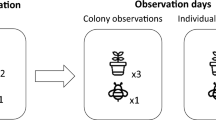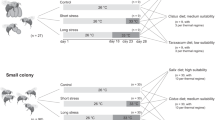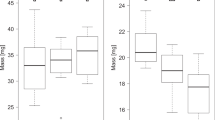Abstract
Pollinators are in global decline and agricultural pesticides are a potential driver of this. Recent studies have suggested that pesticides may significantly impact bumblebee colonies—an important and declining group of pollinators. Here, we show that colony-founding queens, a critical yet vulnerable stage of the bumblebee lifecycle, are less likely to initiate a colony after exposure to thiamethoxam, a neonicotinoid insecticide. Bombus terrestris queens were exposed to field-relevant levels of thiamethoxam and two natural stressors: the parasite Crithidia bombi and varying hibernation durations. Exposure to thiamethoxam caused a 26% reduction in the proportion of queens that laid eggs, and advanced the timing of colony initiation, although we did not detect impacts of any experimental treatment on the ability of queens to produce adult offspring during the 14-week experimental period. As expected from previous studies, the hibernation duration also had an impact on egg laying, but there was no significant interaction with insecticide treatment. Modelling the impacts of a 26% reduction in colony founding on population dynamics dramatically increased the likelihood of population extinction. This shows that neonicotinoids can affect this critical stage in the bumblebee lifecycle and may have significant impacts on population dynamics.
This is a preview of subscription content, access via your institution
Access options
Access Nature and 54 other Nature Portfolio journals
Get Nature+, our best-value online-access subscription
$29.99 / 30 days
cancel any time
Subscribe to this journal
Receive 12 digital issues and online access to articles
$119.00 per year
only $9.92 per issue
Buy this article
- Purchase on Springer Link
- Instant access to full article PDF
Prices may be subject to local taxes which are calculated during checkout



Similar content being viewed by others
References
Corbet, S. A., Williams, I. H. & Osborne, J. L. Bees and the pollination of crops and wild flowers in the European community. Bee World 72, 47–59 (1991).
Klein, A. M. et al. Importance of pollinators in changing landscapes for world crops. Proc. R. Soc. Lond. B 274, 303–313 (2007).
Ollerton, J., Winfree, R. & Tarrant, S. How many flowering plants are pollinated by animals? Oikos 120, 321–326 (2011).
Garibaldi, L. A. et al. Wild pollinators enhance fruit set of crops regardless of honey bee abundance. Science 339, 1608–1611 (2013).
Nieto, A. et al. European Red List of Bees (Publication Office of the European Union, Luxembourg, 2014).
Williams, P. H. The distribution and decline of British bumble bees (Bombus Latr). J. Apic. Res. 21, 236–245 (1982).
Fitzpatrick, Ú. et al. Rarity and decline in bumblebees—a test of causes and correlates in the Irish fauna. Biol. Cons. 136, 185–194 (2007).
Cameron, S. A. et al. Patterns of widespread decline in North American bumble bees. Proc. Natl Acad. Sci. USA 108, 662–667 (2011).
Schmid-Hempel, R. et al. The invasion of southern South America by imported bumblebees and associated parasites. J. Anim. Ecol. 83, 823–837 (2014).
Carvell, C. et al. Declines in forage availability for bumblebees at a national scale. Biol. Cons. 132, 481–489 (2006).
Meeus, I., Brown, M. J. F., De Graaf, D. C. & Smagghe, G. Effects of invasive parasites on bumble bee declines. Cons. Biol. 25, 662–671 (2011).
Fürst, M. A., McMahon, D. P., Osborne, J. L., Paxton, R. J. & Brown, M. J. F. Disease associations between honeybees and bumblebees as a threat to wild pollinators. Nature 506, 364–366 (2014).
McMahon, D. P. et al. A sting in the spit: widespread cross‐infection of multiple RNA viruses across wild and managed bees. J. Anim. Ecol. 84, 615–624 (2015).
Stout, J. C. & Morales, C. L. Ecological impacts of invasive alien species on bees. Apidologie 40, 388–409 (2009).
Memmott, J., Craze, P. G., Waser, N. M. & Price, M. V. Global warming and the disruption of plant–pollinator interactions. Ecol. Lett. 10, 710–717 (2007).
Kerr, J. T. et al. Climate change impacts on bumblebees converge across continents. Science 349, 177–180 (2015).
Vanbergen, A. J. et al. Threats to an ecosystem service: pressures on pollinators. Front. Ecol. Environ. 11, 251–259 (2013).
Godfray, H. C. J. et al. A restatement of the natural science evidence base concerning neonicotinoid insecticides and insect pollinators. Proc. R. Soc. Lond. B 281, 20140558 (2014).
Godfray, H. C. J. et al. A restatement of recent advances in the natural science evidence base concerning neonicotinoid insecticides and insect pollinators. Proc. R. Soc. Lond. B 282, 20151821 (2015).
Woodcock, B. A. et al. Impacts of neonicotinoid use on long-term population changes in wild bees in England. Nat. Commun. 7, 12459 (2016).
Laycock, I., Lenthall, K. M., Barratt, A. T. & Cresswell, J. E. Effects of imidacloprid, a neonicotinoid pesticide, on reproduction in worker bumble bees (Bombus terrestris). Ecotoxicology 21, 1937–1945 (2012).
Bryden, J., Gill, R. J., Mitton, R. A. A., Raine, N. E. & Jansen, V. A. A. Chronic sublethal stress causes bee colony failure. Ecol. Lett. 16, 1463–1469 (2013).
Baron, G. L., Raine, N. E. & Brown, M. J. F. Impact of chronic exposure to a pyrethroid pesticide on bumblebees and interactions with a trypanosome parasite. J. Appl. Ecol. 51, 460–469 (2014).
Fauser-Misslin, A., Sadd, B. M., Neumann, P. & Sandrock, C. Influence of combined pesticide and parasite exposure on bumblebee colony traits in the laboratory. J. Appl. Ecol. 51, 450–459 (2014).
Stanley, D. A., Smith, K. E. & Raine, N. E. Bumblebee learning and memory is impaired by chronic exposure to a neonicotinoid pesticide. Sci. Rep. 5, 16508 (2015).
Baron, G. L., Raine, N. E. & Brown, M. J. F. General and species-specific impacts of a neonicotinoid insecticide on the ovary development and feeding of wild bumblebee queens. Proc. R. Soc. Lond. B 284, 20170123 (2017).
Stanley, D. A. & Raine, N. E. Chronic exposure to a neonicotinoid pesticide alters the interactions between bumblebees and wild plants. Funct. Ecol. 30, 1132–1139 (2016).
Gill, R. J., Ramos-Rodriguez, O. & Raine, N. E. Combined pesticide exposure severely affects individual- and colony-level traits in bees. Nature 491, 105–108 (2012).
Whitehorn, P. R., O’Connor, S., Wackers, F. L. & Goulson, D. Neonicotinoid pesticide reduces bumble bee colony growth and queen production. Science 336, 351–352 (2012).
Gill, R. J. & Raine, N. E. Chronic impairment of bumblebee natural foraging behaviour induced by sublethal pesticide exposure. Funct. Ecol. 28, 1459–1471 (2014).
Feltham, H., Park, K. & Goulson, D. Field realistic doses of pesticide imidacloprid reduce bumblebee pollen foraging efficiency. Ecotoxicology 23, 317–323 (2014).
Stanley, D. A. et al. Investigating the impacts of field-realistic exposure to a neonicotinoid pesticide on bumblebee foraging, homing ability and colony growth. J. Appl. Ecol. 53, 1440–1449 (2016).
Stanley, D. A. et al. Neonicotinoid pesticide exposure impairs crop pollination services provided by bumblebees. Nature 528, 548–550 (2015).
Rundlöf, M. et al. Seed coating with a neonicotinoid insecticide negatively affects wild bees. Nature 521, 77–80 (2015).
Woodcock, B. A. et al. Country-specific effects of neonicotinoid pesticides on honey bees and wild bees. Science 356, 1393–1395 (2017).
Ellis, C. et al. The neonicotinoid insecticide thiacloprid impacts upon bumblebee colony development under field conditions. Environ. Sci. Technol. 51, 1727–1732 (2017).
Sladen, F. W. L. The Humble-Bee: its Life-History and How to Domesticate it, With Descriptions of All the British Species, of Bombus and Psithyrus (Macmillan, London, 1912).
Williams, G. R. et al. Neonicotinoid pesticides severely affect honey bee queens. Sci. Rep. 5, 14621 (2015).
Wu-Smart, J. & Spivak, M. Sub-lethal effects of dietary neonicotinoid insecticide exposure on honey bee queen fecundity and colony development. Sci. Rep. 6, 32108 (2016).
Fauser, A., Sandrock, C., Neumann, P. & Sadd, B. M. Neonicotinoids override a parasite exposure impact on hibernation success of a key bumblebee pollinator. Ecol. Entomol. 42, 306–314 (2017).
Goulson, D. An overview of the environmental risks posed by neonicotinoid insecticides. J. Appl. Ecol. 50, 977–987 (2013).
Forister, M. L. et al. Increasing neonicotinoid use and the declining butterfly fauna of lowland California. Biol. Lett. 12, 2016047 (2016).
Hallmann, C. A., Foppen, R. P., van Turnhout, C. A., de Kroon, H. & Jongejans, E. Declines in insectivorous birds are associated with high neonicotinoid concentrations. Nature 511, 341–343 (2014).
Alford, D. V. A study of the hibernation of bumblebees (Hymenoptera: Bombidae) in southern England. J. Anim. Ecol. 38, 149–170 (1969).
Holm, S. N. Weight and life length of hibernating bumble bee queens (Hymenoptera: Bombidae) under controlled conditions. Entomol. Scand. 3, 313–320 (1972).
Beekman, M., van Stratum, P. & Lingeman, R. Diapause survival and post-diapause performance in bumblebee queens (Bombus terrestris). Entomol. Exp. Appl. 89, 207–214 (1998).
Korner, P. & Schmid-Hempel, P. Effects of sperm on female longevity in the bumble-bee Bombus terrestris L. Proc. R. Soc. Lond. B 270, S227–S229 (2003).
Yourth, C. P., Brown, M. J. F. & Schmid-Hempel, P. Effects of natal and novel Crithidia bombi (Trypanosomatidae) infections on Bombus terrestris hosts. Insectes Soc. 55, 86–90 (2008).
Brown, M. J. F., Schmid-Hempel, R. & Schmid-Hempel, P. Strong context-dependent virulence in a host-parasite system: reconciling genetic evidence with theory. J. Anim. Ecol. 72, 994–1002 (2003).
Hanski, I. & Ovaskainen, O. The metapopulation capacity of a fragmented landscape. Nature 404, 755–758 (2000).
Baer, B. & Schmid-Hempel, P. Unexpected consequences of polyandry for parasitism and fitness in the bumblebee, Bombus terrestris. Evolution 55, 1639–1643 (2001).
Zuur, A., Hilbe, J. M. & Ieno, E. N. A Beginner’s Guide to GLM and GLMM with R (Highland Statistics, Newburgh, 2013).
Thornhill, J. A., Jones, J. T. & Kusel, J. R. Increased oviposition and growth in an immature Biomphalaria glabrata after exposure to Schistoma mansoni. Parasitology 93, 443–450 (1986).
Chadwick, W. & Little, T. J. A parasite-mediated life-history shift in Daphnia magna. Proc. R. Soc. Lond. B 272, 505–509 (2005).
Sakwinska, O. Response to fish kairomone in Daphnia galeata life history traits relies on shift to earlier instar at maturation. Oecologia 131, 409–417 (2002).
Moret, Y. & Schmid-Hempel, P. Social life-history response to individual immune challenge of workers of Bombus terrestris L.: a possible new cooperative phenomenon. Ecol. Lett. 7, 146–152 (2004).
Boncristiani, H. et al. Direct effect of acaricides on pathogen loads and gene expression levels in honey bees Apis mellifera. J. Insect Physiol. 58, 613–620 (2012).
Aufauvre, J. et al. Transcriptome analyses of the honeybee response to Nosema ceranae and insecticides. PLoS ONE 9, e91686 (2014).
Elston, C., Thompson, H. M. & Walters, K. F. A. Sub-lethal effects of thiamethoxam, a neonicotinoid pesticide, and propiconazole, a DMI fungicide, on colony initiation in bumblebee (Bombus terrestris) micro-colonies. Apidologie 44, 563–574 (2013).
Sandrock, C. et al. Sublethal neonicotinoid insecticide exposure reduces solitary bee reproductive success. Agric. For. Entomol. 16, 119–128 (2014).
Cresswell, J. E., Merritt, S. Z. & Martin, M. M. The effect of dietary nicotine on the allocation of assimilated food to energy metabolism and growth in fourth-instar larvae of the southern armyworm, Spodoptera eridania (Lepidoptera: Noctuidae). Oecologia 89, 449–453 (1992).
Cresswell, J. E., Robert, F.-X. L., Florance, H. & Smirnoff, N. Clearance of ingested neonicotinoid pesticide (imidacloprid) in honey bees (Apis mellifera) and bumblebees (Bombus terrestris). Pest Manag. Sci. 70, 332–337 (2014).
Krupke, C. H., Hunt, G. J., Eitzer, B. D., Andino, G. & Given, K. Multiple routes of pesticide exposure for honey bees living near agricultural fields. PLoS ONE 7, e29268 (2012).
Stewart, S. D. et al. Potential exposure of pollinators to neonicotinoid insecticides from the use of insecticide seed treatments in the mid-Southern United States. Environ. Sci. Technol. 48, 9762–9769 (2014).
Botías, C. et al. Neonicotinoid residues in wildflowers, a potential route of chronic exposure for bees. Environ. Sci. Technol. 49, 12731–12740 (2015).
Garthwaite, D. et al. Arable Crops in the United Kingdom 2014 (Food and Environment Research Agency, York, 2014).
Kessler, S. C. et al. Bees prefer foods containing neonicotinoid pesticides. Nature 521, 74–76 (2015).
Scholer, J. & Krischik, V. Chronic exposure of imidacloprid and clothianidin reduce queen survival, foraging, and nectar storing in colonies of Bombus impatiens. PLoS ONE 9, e91573 (2014).
Carolan, J. C. et al. Colour patterns do not diagnose species: quantitative evaluation of a DNA barcoded cryptic bumblebee complex. PLoS ONE 7, e29251 (2012).
Cole, R. J. Application of triangulation method to purification of Nosema spores from insect tissues. J. Invertebr. Pathol. 15, 193–195 (1970).
Ulrich, Y., Sadd, B. M. & Schmid-Hempel, P. Strain filtering and transmission of a mixed infection in a social insect. J. Evol. Biol. 24, 354–362 (2011).
Thompson, H. et al. Effects of Neonicotinoid Seed Treatments on Bumble Bee Colonies under Field Conditions (Food and Environment Research Agency, York, 2013).
David, A. et al. Widespread contamination of wildflower and bee-collected pollen with complex mixtures of neonicotinoids and fungicides commonly applied to crops. Environ. Int. 88, 169–178 (2016).
R Development Core Team. R: A Language and Environment for Statistical Computing (R Foundation for Statistical Computing, Vienna, Austria, 2014).
Bates, D., Maechler, M., Bolker, B. & Walker, S. lme4: Linear Mixed-Effects Models using ‘Eigen’ and S4. R Package Version 1.1–7 (2014); http://lme4.r-forge.r-project.org/.
Therneau, T. A Package for Survival Analysis in S. R package v. 2.37-7 (2014); https://CRAN.R-project.org/package=survival.
Zuur, A., Ieno, E. N., Walker, N., Saveliev, A. A. & Smith, G. M. Mixed Effects Models and Extensions in Ecology with R (Springer, New York, 2009).
Johnson, J. B. & Omland, K. S. Model selection in ecology and evolution. Trends Ecol. Evol. 19, 101–108 (2004).
Baer, B. & Schmid-Hempel, P. Experimental variation in polyandry affects parasite loads and fitness in a bumble-bee. Nature 397, 151–154 (1999).
Mills, M. Introducing Survival and Event History Analysis (SAGE, London, 2011).
Acknowledgements
The authors thank S. Baldwin, B. McCrea, O. Ramos-Rodriguez and D. Wells for assistance in the laboratory and L. Evans, M. Fürst, C. Jones, E. Leadbeater, F. Manfredini, K. Smith and D. Stanley for comments. We thank The Crown Estate for permission to collect wild bumblebees at Windsor Great Park and S. Doble for permission to survey fields at Shiplake Farm. This study was supported by the UK Insect Pollinators Initiative grants BB/I000178/1 (awarded to N.E.R.) and BB/1000151/1 (awarded to M.J.F.B. and V.A.A.J.), funded jointly by the Living with Environmental Change programme, Biotechnology and Biological Sciences Research Council, Wellcome Trust, Scottish Government, Department for Environment, Food and Rural Affairs and Natural Environment Research Council, and a Natural Environment Research Council studentship to G.L.B. N.E.R. is supported as the Rebanks Family Chair in Pollinator Conservation by The W. Garfield Weston Foundation.
Author information
Authors and Affiliations
Contributions
G.L.B., M.J.F.B. and N.E.R. conceived the project and designed the experiment. G.L.B. carried out the experiment and statistical analyses. V.A.A.J. carried out the modelling. All authors contributed to writing the paper.
Corresponding authors
Ethics declarations
Competing interests
The authors declare no competing financial interests.
Additional information
Publisher’s note: Springer Nature remains neutral with regard to jurisdictional claims in published maps and institutional affiliations.
Electronic supplementary material
Supplementary Information
Supplementary Tables 1–9; modelling details
Supplementary Data Guide
Description of Supplementary Data 1
Supplementary Data 1
Description: Queen data
Rights and permissions
About this article
Cite this article
Baron, G.L., Jansen, V.A.A., Brown, M.J.F. et al. Pesticide reduces bumblebee colony initiation and increases probability of population extinction. Nat Ecol Evol 1, 1308–1316 (2017). https://doi.org/10.1038/s41559-017-0260-1
Received:
Accepted:
Published:
Issue Date:
DOI: https://doi.org/10.1038/s41559-017-0260-1
This article is cited by
-
Do diesel exhaust particles in pollen affect colony founding in the bumble bee Bombus terrestris?
Insectes Sociaux (2024)
-
Pesticide use negatively affects bumble bees across European landscapes
Nature (2024)
-
Multi-target scenario discovery to plan for sustainable food and land systems in Australia
Sustainability Science (2023)
-
Sublethal effects of thiamethoxam on immune system cells in the workers of Bombus terrestris (Hymenoptera: Apidae)
Environmental Science and Pollution Research (2023)
-
Protecting pollinators and our food supply: understanding and managing threats to pollinator health
Insectes Sociaux (2023)



